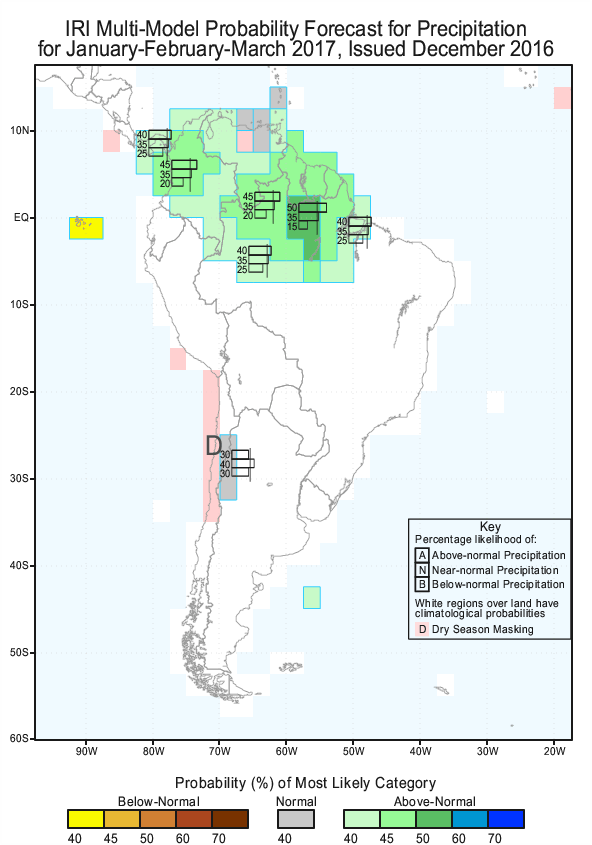| January 13, 2016 | No.94 |
December 2016 & Annual Totals
(Back Issues Here)
December brought less rain as we clearly moved into the dry season. The Palmira Station measured 2.17 inches of rain. Our total for the year 2016 is 118.60 inches.
Thanks again to all those who contribute their monthly rain data. Here are the totals for December of 2016 and for the year 2016 in the various District of Boquete areas.
Rainfall for December 2016 |
|||
Area |
Contributors |
December |
Total for 2016 |
El Santuario |
Terry Zach |
6.98 |
75.32 |
Jaramillo Abajo |
Sela Burkholder |
9.29 |
152.22 |
Jaramillo Arriba |
Steve Sarner |
12.62 |
174.66 |
Brisas Boquetenas |
Austin Perry |
5.30 |
206.40 |
Los Molinos |
Fred Donelson |
12.59 |
219.53 |
Los Naranjos |
Craig Bennett |
7.70 |
n/a |
Lucero (Cielo Paraiso) |
Michael Mullin |
7.63 |
220.89 |
Valle Escondido |
Wayne Beighle |
6.27 |
n/a |
Palmira Abajo |
Clyde Page |
3.34 |
n/a |
Palmira Abajo |
Betty Gray |
3.62 |
111.06 |
Palmira Arriba |
Lloyd Cripe |
2.17 |
118.60 |
n/a = not currently available but will be posted when available |
|||
The highest rainfall for December was 12.62 inches at Jaramillo Arriba (Sarner). He reports that this was the highest December rainfall that they have recorded over the years. The lowest was recorded at the Palmira Arriba Station with 2.17 inches.
The highest recorded rainfall for the year 2016 was at Lucero with 220.89 inches (18.4 feet). That is a lot of rain. In fact that is 1480 gallons of water per square meter!
The lowest rainfall for the year 2016 was 75.32 inches at El Santuario with 75.32 inches.
Did we have a normal December and Annual Rainfall? Take a look at this monthly rainfall graph which includes 2016. Don't let the chart scare you. However, pay attention and take a close look at the details to see how this year compares to previous years and the averages over the 10 years of data collection at Palmira. In summary, we had about an inch less December rainfall compared to the average. Our annual total of 118.60 in 2016 is less than the average annual rainfall of 146.4 inches over the 10 years.
I am scheduled to give the Tuesday Meeting on February 7 and will share more analysis of this years weather data as well as 10 years of data collection. I hope you will attend.
You can read more about the annual weather up north in mainland United States in this article by Bob Henson with Weather Underground.
The latest ENSO Cycle Report is saying that "La Niña conditions are present. Equatorial sea surface temperatures (SSTs) are below average in the central and eastern Pacific Ocean. A transition to ENSO-neutral is favored during January-March 2017."
The IRI (International Research Institute for Climate and Society) (select South America from the Region menu) is reporting the following precipitation predictions for January-February-March of 2017. Note a 40% probability that our area will have slightly above average precipitation.

ETESA's, hydrology and meteorology section is predicting a strong probability that the our area will have somewhat higher precipitation in the areas north of Bajo Boquete and normal precipitation in other areas of Boquete in January 2017. You can read their report and check out the details for January in the documents section at this link.
We are now well into the dry season and experiencing considerable winds. This is a common annual occurrence related to high pressure polar air masses over the north dipping south creating high pressures in the Caribbean which then cause the air to seek the ITCZ low pressure areas. The south moving air becomes our NE Trade Winds. With these winds come the debris moisture from the rising Caribbean moist air that we call the Bajareque. You can thank the wind and moisture blowing in over Baru and the mountain range for our beautiful rainbows this time of year.
Due to all of this, when we got back from Christmas and New Year in the Seattle, Washington area, we awoke to this Palmira Morning Rainbow on January 11 out of our upstairs Baru window. Thanks to the winds and drizzle! Note the Bajareque blowing over from the NE.
We are glad to be back in Paradise where the temperatures are no where near freezing, the roads are without slick stuff, and the sun comes up and goes down 1n a regular routine. We are most fortunate.
Lloyd Cripe
